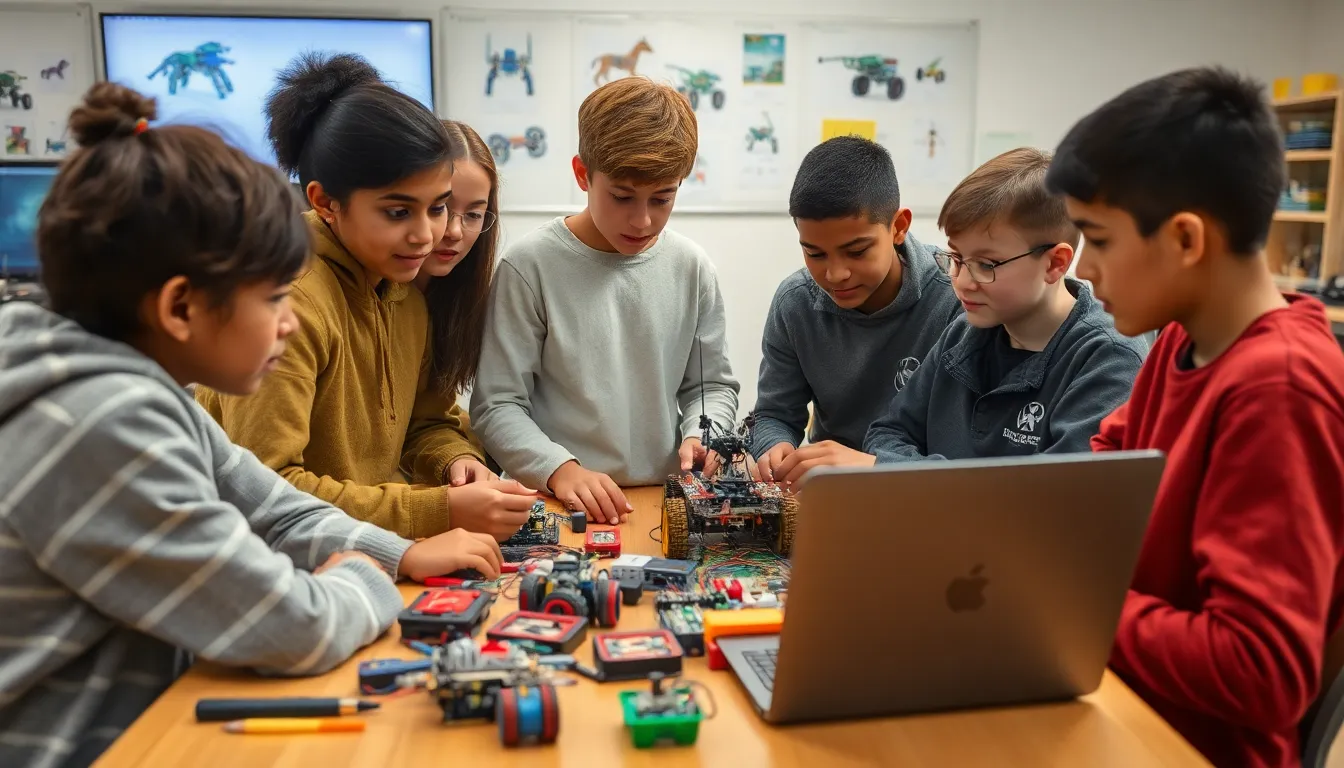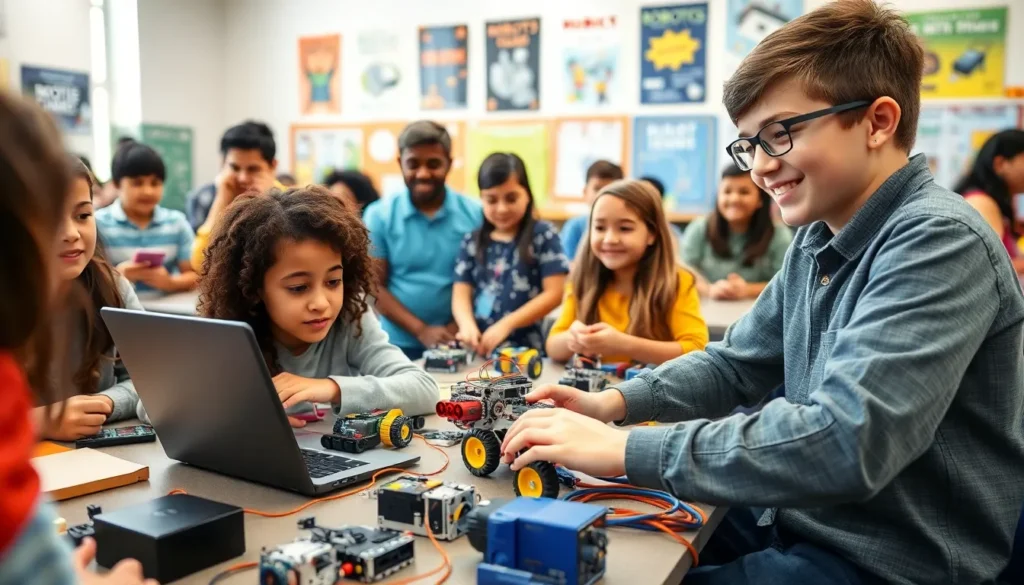Table of Contents
ToggleIn an age where technology shapes every aspect of life, robotics classes have emerged as a vital educational frontier. These classes not only ignite creativity but also equip students with essential skills in coding, engineering, and problem-solving. As more schools and institutions embrace robotics, the demand for knowledgeable instructors and engaging curricula continues to rise.
From young children to adults, learners of all ages can dive into the world of robotics. These classes foster teamwork and innovation, encouraging students to design and build their own robots. As they navigate challenges and celebrate successes, participants gain confidence and a deeper understanding of the technology that drives our future.
Overview of Robotics Classes
Robotics classes provide a structured environment where students engage in hands-on learning activities focused on designing, building, and programming robots. Such classes are available at various educational institutions, including schools, community centers, and specialized training programs.
Robotics curricula typically cover topics including:
- Fundamentals of Robotics: Students learn key concepts like sensors, actuators, and microcontrollers.
- Programming Skills: Classes introduce programming languages such as Python and C++, enabling students to code robot behavior.
- Mechanical Design: Participants explore the principles of mechanical engineering to create robust structures.
- Electronics: Classes incorporate basic electronics, teaching students about circuits and power systems.
Robotics classes cater to diverse age groups, from young children to adults, encouraging creativity and critical thinking. They foster collaboration by incorporating group projects, where students work together to solve complex problems. Robotics education emphasizes experiential learning, allowing students to iterate designs based on tests and feedback.
The global demand for skills in robotics continues to grow, making these classes crucial for career pathways in technology, engineering, and related fields. Various competitions and challenges further enhance learning experiences by allowing students to apply their skills in real-world scenarios.
Benefits of Taking Robotics Classes

Robotics classes provide numerous advantages, including enhanced skill development and expanded career opportunities. Participants gain practical experience while cultivating essential abilities that align with industry demands.
Skill Development
Skill development occurs through hands-on experiences in robotics classes. Students learn various competencies, including:
- Programming Skills: Participants gain proficiency in popular programming languages such as Python and C++.
- Engineering Principles: Classes focus on mechanical design, enabling learners to understand structural integrity and functionality.
- Problem-Solving Techniques: Students engage in real-world challenges, fostering critical thinking and innovative solutions.
- Collaboration Skills: Group projects encourage teamwork, enhancing communication abilities and fostering diverse perspectives.
These competencies prepare individuals for both academic success and practical applications in technology.
Career Opportunities
Robotics classes open a broad array of career opportunities across many sectors. Potential careers include:
- Robotics Engineer: These professionals design and develop robots for various applications.
- Software Developer: Developers create software that drives robotic systems, utilizing programming knowledge gained in classes.
- Automation Technician: Technicians work with automated systems, ensuring optimal functionality and maintenance.
- Research Scientist: In academia or industry, researchers explore advancements in robotics and artificial intelligence.
The growing emphasis on automation and robotics in multiple industries makes expertise in this field highly valuable. Participants in robotics classes position themselves to take advantage of these emerging opportunities.
Types of Robotics Classes
Robotics classes come in various formats and cater to different audiences, enhancing accessibility and engagement in learning. This section covers key distinctions in robotics education.
Online vs. In-Person
- Online Classes: Online robotics classes provide flexibility and convenience, allowing students to learn at their own pace from remote locations. Many platforms offer interactive tutorials, video lectures, and virtual collaborative projects, enabling learners to connect with peers and instructors through forums and live sessions.
- In-Person Classes: In-person classes foster hands-on learning experiences with direct access to materials and equipment. Students engage in real-time problem-solving, benefiting from immediate feedback and collaboration with peers. This format often includes physical robotics kits, promoting experimentation and tangible application of concepts.
Age Groups and Skill Levels
- Elementary Students: Classes for elementary students introduce basic concepts of robotics with playful activities and simple building projects. Programs focus on foundational skills such as teamwork and creativity through age-appropriate robotics kits and interactive games.
- Middle School Students: Middle school classes delve into coding and engineering principles, providing a deeper understanding of robotics. Students explore programming languages like Scratch or Blockly, working on more complex projects in teams, which enhances critical thinking and problem-solving skills.
- High School Students: High school robotics classes focus on advanced programming and engineering concepts, including mechanical design and electronics. Participants engage in competitions and challenges, applying their skills to real-world scenarios, which prepares them for further education or careers in technology.
- Adults and Professionals: Adult and professional courses target individuals seeking to upskill or pivot to careers in robotics or automation. These classes often integrate industry-grade tools and real-time projects, providing advanced knowledge in programming, system design, and robotics applications relevant to current job markets.
Choosing the Right Robotics Class
Selecting the right robotics class involves evaluating several factors. Individuals should consider their interests, goals, and available time to ensure an optimal learning experience.
Factors to Consider
- Age Group: Age-specific classes address varying skill levels and interests. Elementary programs provide foundational knowledge, while high school courses cover advanced principles and applications.
- Skill Level: Different courses cater to beginners and advanced learners. Newcomers benefit from introductory sessions, while experienced students can explore complex projects and coding languages.
- Class Format: Online and in-person classes present distinct advantages. Online formats offer flexibility and self-paced learning, while in-person options facilitate hands-on experiences and real-time collaboration.
- Curriculum Focus: Evaluate the topics covered in each class. Some classes concentrate on programming, while others emphasize mechanical design or electronics. Aligning the curriculum with personal interests supports deeper engagement.
- Instructor Expertise: Experienced instructors enhance the learning experience. Assessing the qualifications and backgrounds of instructors can provide insight into the quality of education offered.
- Class Size: Smaller class sizes often allow for more personalized attention. Consider the instructor-to-student ratio to ensure sufficient access to guidance and resources.
Recommended Programs
| Program Name | Age Group | Format | Focus Area |
|---|---|---|---|
| Robotics for Beginners | 8-12 years | In-person | Basic robotics concepts |
| Intermediate Robotics | 12-15 years | Online | Programming and design |
| High School Engineering | 15-18 years | Hybrid | Advanced robotics |
| Adult Robotics Workshop | 18+ years | In-person | Career transition |
| Coding for Robotics | 10+ years | Online | Python and C++ coding |
| Electronics Fundamentals | 14+ years | In-person | Electronics and circuitry |
Choosing the right program helps individuals gain relevant skills while enjoying the learning process. Consider these factors and recommended programs to find the ideal fit for robotic education needs.
Robotics classes offer invaluable opportunities for learners of all ages. They not only nurture essential skills but also inspire creativity and teamwork. As technology continues to evolve, the demand for expertise in robotics will only grow.
By participating in these classes, individuals can prepare themselves for a wide range of career paths. Whether through online or in-person formats, students can find the right fit to match their interests and goals.
Investing time in robotics education equips learners with the tools they need to thrive in an increasingly automated world. Embracing this learning journey could open doors to exciting futures in technology and engineering.



